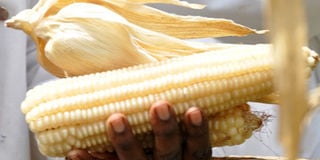New regional staple foods standards to boost trade

Cereals. A man holds a maize cob. The East African standards of staple foods will affect cereals such as maize, millet, wheat, sorghum, rice and pulses such as beans and peas. PHOTO BY ERONIE KAMUKAMA
What you need to know:
- According to EAGC, cereals such as maize continue facing rejection not only because of discoloration of grains but also high aflatoxin levels that are harmful to consumers.
- In the wake of these frustrations, EAC member states agreed to a quality framework which sets out standards for the entire region.
Kampala. Intra-regional trade in quality cereals and pulses is expected to increase following the launch of the gazetted East African standards of staple foods.
Speaking in an interview on the sidelines of the launch of the nine standards for staple foods on Wednesday by East Africa Grain Council (EAGC) in Kampala, Mr Gerald Masila, executive director EAGC, said the lack of harmonised regional standards has for a long time barred trade as each East African country has been using its standards.
“We have lost out on a market position. I do not have a number right now.
But Uganda could easily double its sales to the region by more than 100 per cent if the quality standards of the grains produced here meet the specifications. This means there would be fewer rejections and much more access to markets. Uganda’s commodities would be able to fetch a better price and sign up continuous supply agreements,” he said.
According to EAGC RATIN, a system that gives farmers, traders and processors a gateway to regional market information, Uganda has exported about 10.1m metric tonnes of cereals and pulses within EAC and The Common Market for Eastern and Southern Africa (Comesa) countries in the last seven years. On average, the country has for the last seven years been earning Shs1.9m per metric tonne of cereals and pulses exported.
Cereals
The standards will affect cereals such as maize, millet, wheat, sorghum, rice and pulses such as beans and peas.
The revised standards are expected to become legally binding in all states four months after publication in the gazette.
Explaining the contents of the standards, Mr Samwel Rutto, regional manager-Structured Trading Systems at EAGC, said, “We have the general quality specifications which look at the hygiene of the grains. Then we have the specific parameters where we have moisture issues, foreign matter, diseased or broken grains.”
Exporters and millers of cereals have been urged to certify their produce as voluntary certification is set to cease.
“This standard will be approved and mandatory. You will not be allowed to trade unless your product is certified,” deputy executive director Standards at UNBS, Ms Patricia Ejalu, said about a regulation that is in the offing.
Absence of standards
According to EAGC, cereals such as maize continue facing rejection not only because of discoloration of grains but also high aflatoxin levels that are harmful to consumers.
Consequently, Mr Masila said most of the region’s trade in grains has remained informal, with traders selling small quantities of untested grains across borders.
“This increased the cost of doing trade and made the produce expensive to the farmers and consumers because of the way the system works,” he said.
In the wake of these frustrations, EAC member states agreed to a quality framework which sets out standards for the entire region. EAC gazetted the standards last year in December.
Within the next six months, Uganda National Bureau of Standards (UNBS) and Ministry of Trade will adopt and domesticate the standards.
EAGC acknowledged that compliance to standards has, for a long time, been very low due to a high cost attached to the grain certification process and limited access to laboratories for testing and grading grains.




